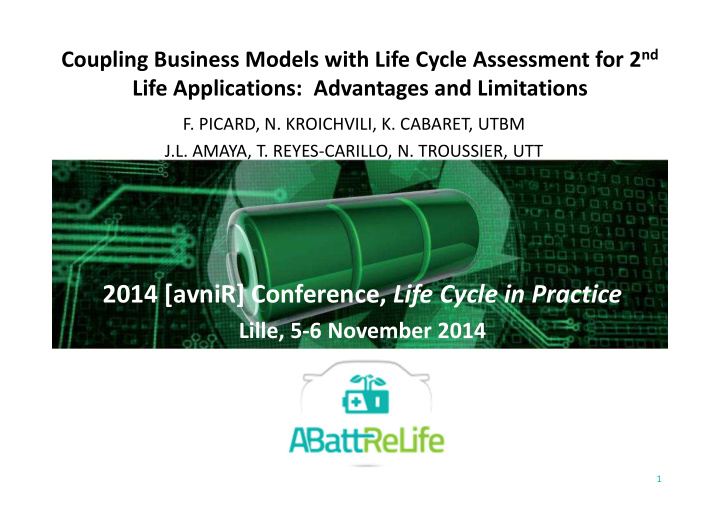



Coupling Business Models with Life Cycle Assessment for 2 nd Life Applications: Advantages and Limitations F. PICARD, N. KROICHVILI, K. CABARET, UTBM J.L. AMAYA, T. REYES-CARILLO, N. TROUSSIER, UTT 2014 [avniR] Conference, Life Cycle in Practice Lille, 5-6 November 2014 1
Introduction • Rising environmental concerns since the 1990s (Kyoto Protocol, IPPC’s conclusions, negotiations of a global agreement on greenhouse gases emissions reduction) � Increasing attention on environmental impacts of production activities and search for sustainable development models � Fostering product reuse, second life applications and recycling • LCA and BM approaches may support the reflection towards more sustainable models of production 2
1- Weaknesses of BM approach Traditional BM approach describes how value is created and captured However: 1. Environmental value is not taken into account in value (product or use) � Environmental impacts of production activities are scarcely analyzed 2. Analysis mainly done at a company level � 2 nd applications are not necessarily produced by the same firm that provided the first ones � 2 nd applications need to introduce new actors, sometimes a completely new branch of activities into the analysis NB: Interesting new perspectives offered by open BM 3
2- Weaknesses of LCA approach The LCA approach enables to identify environmental impacts through the identification of resource and energy consumption as well as waste production and elementary flows However: 1. A restricted view of economic impacts � The economic dimension of activity is reduced to costs 2. A fuzzy perimeter of activities and of the actors’ network, due to the introduction of 2 nd life applications � The functional unit, at the core of LCA, becomes difficult to define 3. A difficult allocation of environmental impacts between several product lives 4
3- A BM approach to improve LCA • A deeper analysis of economic issues • A contribution of open BM to identify actors involved in 2 nd life applications • A new conception of the life cycle model, able to allocate environmental impacts to several product applications 5
4- Using LCA in BM approach • Internalizing the environmental impact of economic activities by introducing environmental value • Introducing a global vision of the product life cycle in and going beyond a linear vision of sequential BMs in favor of a systemic and circular vision Consequences: 1. Embracing potentially different fields of application, different actors 2. Challenging actors of the 1 st life and questioning their ability to capture the 2 nd life value of a product partially created in the 1 st life 6 WP4 « Business Models for batteries 2nd Life and recycling solutions »
Conclusion 5 scenarii of Sustainable BM Same actors Non sequential BM1 BM2 Sequential BM3 BM4 Different actors, outsiders 7 Paris, 15 janvier 2014
Thank You 8
Recommend
More recommend